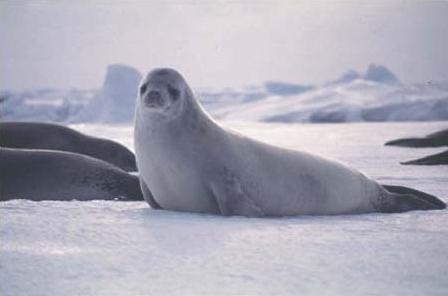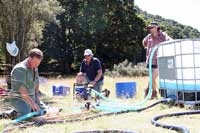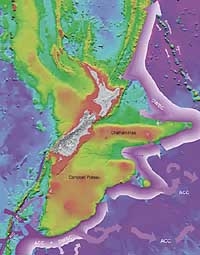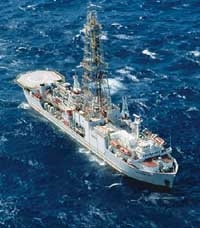PDF of this article (2 MB)

Barbara Manighetti
Giant currents in the deep ocean transport so much heat around the globe that they play a critical role in shaping the earth’s climate.
The ocean is in perpetual motion: that’s obvious to anyone who looks out over the sea. But the tides and waves that we see are just a tiny part of the movement in the ocean as a whole. Most movement comprises large-scale, unseen shifts to equal out water density differences caused by variations in temperature and salinity (saltiness) from the Poles to the Tropics. Dense water (i.e., cold and salty) tends to sink and then flow sideways at its appropriate density level, generating currents that flow from basin to basin, redistributing heat and salt as they go. This is called thermohaline circulation.

Beach or abyss? Sand ripples on the seabed at over 4 km depth look remarkably like those from a tidal estuary or beach and demonstrate that there is water movement at that depth as well as near the ocean surface.
Cold, salty deep water is produced in the seas around Antarctica and the high North Atlantic. Freezing winds cool the surface water and increase its density. The formation of salt-free sea ice causes the surrounding water to become saltier and even more dense. The dense water plummets to abyssal depths and then flows along the seabed, hugging the western margins of ocean basins due to the “steering” effect of the earth’s rotation (the Coriolis effect). The currents created by this process are called Deep Western Boundary Currents.
The Pacific gateway
Today, 40% of the densest deep water enters the world’s ocean via the southwest Pacific, and New Zealand is at the gateway of this huge flow.

The Great Global Conveyor. This map shows the general outline of sinking in the Antarctic and North Atlantic, and entrainment of these deep waters into the Antarctic Circumpolar Current (ACC), which flows clockwise around the entire globe. Northward "spinoffs" from the ACC flow into the Indian Ocean, and through the southwest Pacific gateway into the Pacific. Return shallow flows complete the conveyor-belt loop.
The Deep Western Boundary Current of the southwest Pacific travels 2–5 km below the surface along the east side of the Campbell Plateau, around Chatham Rise and around Hikurangi Plateau (see inset map, below right). On its journey past New Zealand, the boundary current helps to redistribute heat, salt and nutrients. To compensate for this northward flow of deep water, there is a southward movement of shallower water in the upper layers of the ocean. Similarly, in the North Atlantic, deep water is replenished by a northward flow of shallow water in the Gulf Stream. These deep thermohaline currents, with their accompanying shallow flows, are a key factor in the Earth’s climate system.
From the moment of sinking, deep water can take up to 1,500 years to complete its journey around the globe and re-emerge at the surface. During this time, the deep water collects nutrients from material that rains down from the upper ocean. When the deep water nears the surface again in upwelling regions, it supplies food for huge blooms of plankton.
Thus, oceanographers think of global ocean circulation as a gigantic conveyor belt. Deep water from both the Arctic and Antarctic joins the huge ocean current that encircles the Southern Ocean. This current – the Antarctic Circumpolar Current – links the Atlantic, Pacific and Indian oceans (see pages 15–17, this issue). Little or no deep water forms in the Pacific and Indian oceans but differences in water temperature, rainfall and evaporation still lead to large flows in and out of their basins via the Southern Ocean.
Thermohaline circulation is finely balanced, especially in relation to saltiness. A 3% boost in salinity increases the density of seawater as much as a 5°C cooling! The vigour and extent of the deep and shallow flows depend upon a balance between evaporation and fresh water supply, temperature distribution through the ocean, and wind patterns. Any or all of these factors may change as global warming continues.
There have certainly been changes in the past, and NIWA scientists and the Ocean Drilling Program (ODP) have documented fluctuations in the strength of the New Zealand sector of the conveyor belt over ice ages (glacials) and warm periods (interglacials). (For example, see Water & Atmosphere 7(1): 14–16; 8(3): 24–26.)
Glacials to interglacials: natural global warming at work

A detailed map of the seafloor around New Zealand, showing cold deep water entering the Pacific through the southwest Pacific gateway. Some of this water flows north past New Zealand in the Deep Western Boundary Current (DWBC) while the rest continues its eastward flow in the Antarctic Circumpolar Current (ACC). Deepening colour indicates increasing intensity of flow towards the western boundary.
The earth’s climate has seen plenty of changes in the past, with glacials and interglacials occurring in a fixed cycle. We are currently in a rather warm interglacial, but a change to colder conditions is likely over the next few thousand years.
Knowledge of how the ocean and atmosphere behaved during the cold periods and, particularly, during warming intervals – periods of change from maximum glacial to maximum interglacial – can help us to predict the possible future of the planet under a CO2-induced super-warming.
During the last glacial period there was a large reduction in the southward flow of North Atlantic deep water. At the same time, the northward flow of warm, shallow water in the Gulf Stream – Europe’s “heater” – also reduced. So the region quickly cooled down.

The sediment in this deep ocean core, recovered during the Ocean Drilling Program, represents material accumulated over many thousands of years, including organic and inorganic remains that can provide clues to ocean environmental conditions long ago. (Photo: courtesy of the Ocean Drilling Program)
In the south, however, we think that during glacial periods the Deep Western Boundary Current increased its speed around New Zealand but relaxed during interglacials, including the present warm phase which began about 10,000 years ago. In the last major interglacial, ~130–120,000 years ago, the current may have been less vigorous than today. This period is often used as an analogue for predicting the consequences of global warming, since temperatures were 1–2°C warmer than now.
It seems likely that the current’s strength is related to the rate of production of deep water around Antarctica, with higher production during glacials and less in interglacials. This was probably because of changes in the formation of sea ice around the continent, and the resultant fluctuation in the salt content of surface waters.
A short-lived event known as the “Younger Dryas cooling” occurred in the Northern Hemisphere just as warming was getting underway after the last glacial, about 13,000 years ago. Something happened suddenly and dramatically to reduce or cease production of deep water in the northern seas. This catapulted the region back into near-glacial conditions, with cooling in some places estimated to be as much as 10°C in a few decades. No such dramatic event has been demonstrated in the Southern Hemisphere, but evidence is accumulating to suggest that a slow-down or reversal in the post-glacial warming process occurred in Antarctica and in the seas around New Zealand about 1,500–2,000 years before the Younger Dryas event in the north. (The cool period is named after a daisy-like flower, Dryas octopetala, that became common at that time in parts of Europe. The plant also occurred in an earlier cool period, known as the Older Dryas.)
Lessons from the past?
What can we learn from these events of thousands of years ago?
It is possible that, as global temperature increases, the accompanying changes in rainfall, evaporation and sea-ice cover will slow down the formation of deep water in the North Atlantic. The insulating effect of the Southern Ocean means that Antarctic deep-water production is less likely to be affected unless or until warming is further advanced. However, all the oceans communicate via the Antarctic Circumpolar Current. This ensures that, eventually, the impact of Northern Hemisphere changes will reach the New Zealand region – although it may take 500 or so years to arrive.
First effects may be a greater contrast between shallow and deep-water temperatures, leading to changes in the sinking and upwelling behaviour critical for chemical and nutrient cycling in the ocean. Through feedback effects via the atmosphere, however, changes in the ocean can generate abrupt climate events as the system moves into a new mode of operation. In future, switching off the “global heat pump” through greenhouse warming could, ironically, help initiate a new ice age.
The efficiency of the ocean at redistributing heat could be delaying and regulating global warming. Will this persist? There is evidence of large and abrupt changes in ocean circulation that have had major impacts on global climate in the past.
Barbara Manighetti is based at NIWA in Wellington.

The ODP research vessel JOIDES Resolution.

ODP coring rig.

Examining split cores in the laboratory.
